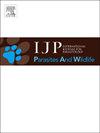揭示了有关有蹄类疟原虫遗传和寄主多样性的未被注意的数据
IF 2
3区 医学
Q3 ECOLOGY
International Journal for Parasitology-Parasites and Wildlife
Pub Date : 2025-06-18
DOI:10.1016/j.ijppaw.2025.101104
引用次数: 0
摘要
众所周知,疟原虫属以引起人类疟疾而闻名,它也感染多种脊椎动物,包括有蹄类动物。尽管有蹄动物中疟原虫的首次报道可以追溯到1913年,但对这些寄生虫的研究仍然很少,在很大程度上被灵长类动物、鸟类和啮齿动物疟原虫的研究所掩盖。一个世纪后的2016年,三份独立出版物首次报道了来自不同宿主物种和不同大陆的有蹄类疟原虫的基因序列,重新引起了人们的兴趣。从那时起,几项研究探索了它们在不同宿主物种和地理区域的遗传多样性。其中,有两项研究调查了非洲森林和热带草原有蹄类动物中的疟原虫,发现了几个新的寄主物种,特别是在Tragelaphus、Syncerus和Cephalophus属中。然而,这些发现在很大程度上没有引起疟原虫研究界的注意,因为这些出版物的主要重点是异种监测(利用吸血蝇及其血食来检测病原体),而不是疟疾寄生虫本身。在这里,我们重新分析这些被忽视的数据,以澄清有蹄类疟原虫的进化关系。系统发育分析证实,这些寄生虫形成一个单系群,不同于感染灵长类动物、啮齿动物和蝙蝠的疟原虫。在这个群体中,确定了两个主要的分支,包括来自各种有蹄类宿主的寄生虫。虽然头虫寄生虫与先前描述的序列聚集在一起,但来自Tragelaphus和Syncerus的寄生虫形成了不同的谱系,可能代表了新的物种。扩大对有蹄类疟原虫的认识,特别是在未开发地区和宿主物种的认识,对于了解这些寄生虫的进化和多样性至关重要。本文章由计算机程序翻译,如有差异,请以英文原文为准。

Bringing to light unnoticed data on the genetic and host diversity of ungulate Plasmodium
The genus Plasmodium, best known for causing malaria in humans, also infects a diverse array of vertebrates, including ungulates. Despite the first report of Plasmodium in ungulates dating back to 1913, research on these parasites has remained scarce, largely overshadowed by studies on primate, avian, and rodent Plasmodium. A century later, in 2016, three independent publications renewed interest by reporting the first genetic sequences of ungulate Plasmodium from different host species and continents. Since then, several studies have explored their genetic diversity across various host species and geographic regions. Among these, two studies investigated Plasmodium in African forest and savanna ungulates, identifying several new host species, particularly within the genera Tragelaphus, Syncerus, and Cephalophus. However, these findings remained largely unnoticed by the Plasmodium research community, as the primary focus of the publications was on xenosurveillance (the use of hematophagous flies and their blood meals to detect pathogens) rather than malaria parasites per se. Here, we reanalyze these overlooked data to clarify the evolutionary relationships of ungulate Plasmodium. Phylogenetic analyses confirm that these parasites form a monophyletic group, distinct from Plasmodium infecting primates, rodents, and bats. Within this group, two main clades were identified, encompassing parasites from various ungulate hosts. While Cephalophus parasites cluster with previously described sequences, those from Tragelaphus and Syncerus form distinct lineages, likely representing novel species. Expanding knowledge of ungulate Plasmodium, particularly in under-explored regions and host species, is crucial for understanding the evolution and diversity of these parasites.
求助全文
通过发布文献求助,成功后即可免费获取论文全文。
去求助
来源期刊

International Journal for Parasitology-Parasites and Wildlife
Medicine-Infectious Diseases
CiteScore
3.80
自引率
5.60%
发文量
113
审稿时长
45 days
期刊介绍:
The International Journal for Parasitology: Parasites and Wildlife (IJP-PAW) publishes the results of original research on parasites of all wildlife, invertebrate and vertebrate. This includes free-ranging, wild populations, as well as captive wildlife, semi-domesticated species (e.g. reindeer) and farmed populations of recently domesticated or wild-captured species (e.g. cultured fishes). Articles on all aspects of wildlife parasitology are welcomed including taxonomy, biodiversity and distribution, ecology and epidemiology, population biology and host-parasite relationships. The impact of parasites on the health and conservation of wildlife is seen as an important area covered by the journal especially the potential role of environmental factors, for example climate. Also important to the journal is ''one health'' and the nature of interactions between wildlife, people and domestic animals, including disease emergence and zoonoses.
 求助内容:
求助内容: 应助结果提醒方式:
应助结果提醒方式:


